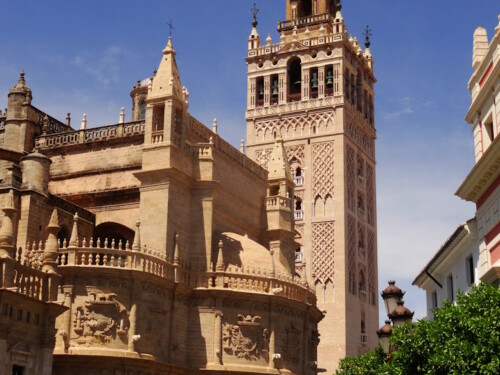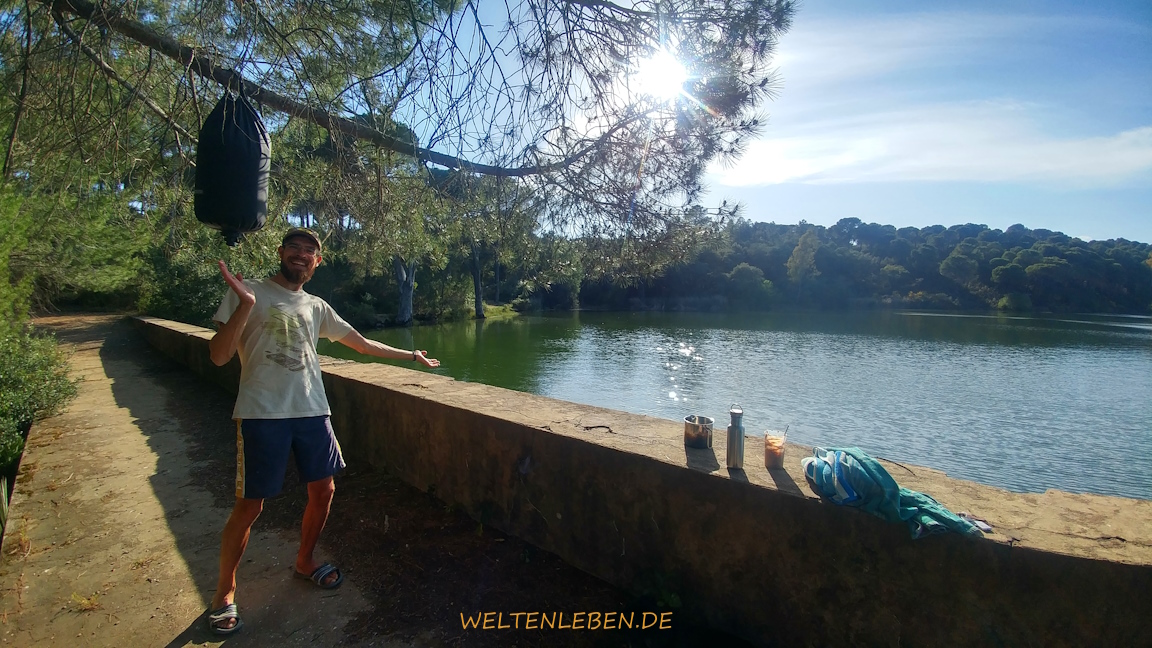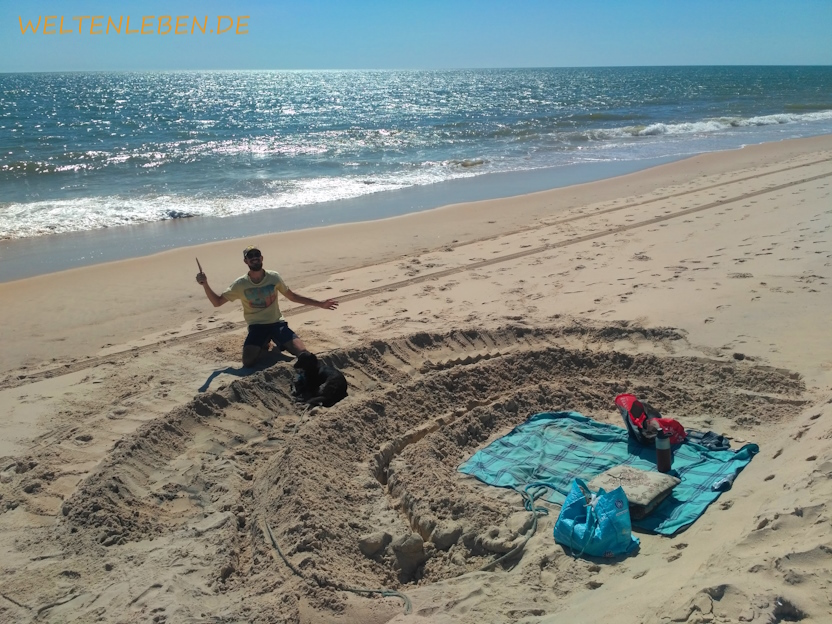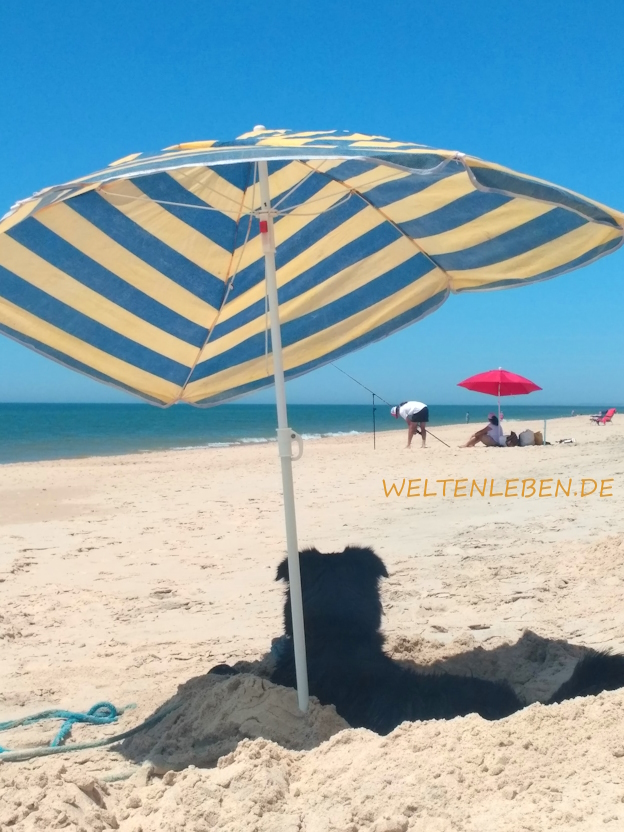It is now the beginning of April 2023 and the temperatures are anything but spring-like, we are heading towards 30 degrees. However, we are now in the hottest part of Andalusia, a little east of Seville, which is also known as “La Sartén”, the frying pan.
Easter is just around the corner! Over the past few weeks, we have already seen posters for Semana Santa – the “Holy Week”, as Holy Week is known in Spain – in every town we have explored, whether large or small. From Palm Sunday to Easter Sunday, one or more elaborate processions take place every day, apparently in almost every town in Andalusia. Easter has a higher priority in Spain than Christmas!
The processions are always organised by different brotherhoods. The procedure is always similar: the procession participants, called nazarenos – meaning “penitents” – wear long robes in different colours depending on the brotherhood. What is particularly striking here is the pointed, high, hood-like headgear, which also covers the face like a mask. There are only holes for the eyes, otherwise the fabric covers the entire face. The Kuklux clan copied these garments, which have been traditionally used in Spain since the 16th century.
The processions are intended to re-enact the Way of the Cross of Jesus Christ. For this purpose, different, elaborately carved, life-size human figures and ensembles of figures are carried by many young men in each procession. This is accompanied by brass band music. The atmosphere is usually described as “sombre”. Accordingly, we looked forward to Semana Santa with excitement and mixed feelings.
But of course we wanted to experience some of it, as we were in Spain at a very opportune time, especially in Andalusia, which is steeped in tradition.
We decided to spend the festivities in the small town of Carmona, which also has a very pretty old town centre and is one of the oldest towns in the whole of Andalusia.
We can park in front of the Roman Gate, the gateway to the old town, and spend the night here. We also enjoy the sweeping view over the neighbouring plain, where the grain is already golden, as the town is situated on a high plateau. We end up staying here from Good Friday, the most important holiday of Holy Week, until Easter Sunday and witness four processions. The atmosphere seems more solemn than sombre and the whole spectacle is really very impressive and worth seeing!
Immerse yourself in these special celebrations and the beauty of Carmona by clicking on the following gallery:


In the centre of the town there is also an ancient site that we visit after Easter. Carmona has been continuously inhabited since prehistoric times and the Romans also left their mark here: There is a necropolis, a necropolis from Roman times, to visit! Countless burial chambers were dug into the rock between the 1st and 3rd centuries AD. Most of them can only be reached by stairs that lead a few metres downhill into the rocky ground. Even today, (restored) paintings can still be seen on the walls and there are fascinating details, such as a hole in the ceiling through which the head of the family would pour wine into the grave on special days, as an offering for the buried.
There are also two huge chambers that are almost the size of halls. There are no more ceilings here and we can look around at our leisure, either from above or standing in the centre of the hall. In those days, large celebrations and even political meetings were held here after the funerals. The high social status of each family was emphasised with columns, domes, gardens and decorations. Fountains and loungers for dining rounded off the whole thing.
The theatre, where animal fights also took place, was located opposite the necropolis. Large parts of the theatre have also been excavated, although it can only be viewed from a distance.
Click on the following gallery to visit the necropolis with us:
Now we are really looking forward to Seville!
This is the capital of Andalusia and the fourth largest city in Spain. Its very special historic centre is actually the largest in Spain and is also one of the largest in Europe.
Seville’s reputation as the “beautiful city” precedes it. And, as we will see, it has earned this reputation!
Despite the size of the city, the different neighbourhoods are very easy to explore by bike, as there are always cycle paths along the streets.
We are lucky enough to find a very central and quiet car park where we can stay for a few nights. And our folding bikes are happy to be able to get out into the fresh air again!
Directly in front of our car park is the beautiful, large Maria-Luisa Park, which dates back to the end of the 19th century. The trees and various types of palm trees here are correspondingly old and large, providing pleasant shade. The air is filled with the twittering of the green parrots that live in the treetops. However, spotting them with the naked eye seems almost impossible; at best you might catch a glimpse of them in flight.
Some tropical-looking plants with the most colourful flowers grow out of the ground, with colourful mosaic-decorated benches in between, where we like to make ourselves comfortable for the time being. There are also several ponds and pavilions and, of course, free drinking water from small fountains, which is available throughout Spain – what a quality of life!
We always like to immerse ourselves in this green lung of the city between our explorations. Now it’s already over 30 degrees during the day and at night the temperatures only drop to 24 degrees. Pure midsummer…
Not far from the park is one of the city’s biggest sights: the “Plaza de España”! Beautiful, huge, semi-circular and with numerous decorations in various shapes and colours. Every day until after sunset, public Flameco performances are also held here during our visit. A dance? An art! An art that captivates and makes you forget time. Passion, grace, emotion – the dancers express all this and more with great intensity, while their crew accompanies them with persistent singing and guitar music. We are very happy to put something back into the bowl that is passed around after each piece.
Jump into the picture with us by clicking on the following gallery:
Seville is also known for its beautiful buildings: the spectacular cathedral Maria de la Sede from the 15th and 16th centuries with its “Giralda”, the 97 metre high square bell tower. There is also another Alcazar – a former Moorish fortress -, the Torre del Oro – the gold tower on the banks of the Guadalquivir river – and the magnificent university, which was once a huge cigar factory. And much, much more, not to mention the many beautiful houses and stately homes that can still be found throughout the old town and in other neighbourhoods. We can hardly get enough of it and enjoy these days to the full.
We will always remember Seville as being particularly worth seeing!
Take a stroll through Seville in the following gallery:



Just ten kilometres behind the city there is another exciting archaeological site. Italica was once the name of this Roman city. It was inhabited for over 900 years, from the 2nd century BC to the 8th century AD.
What remains of it today is a very impressive amphitheatre, which is the third largest of its kind in Rome, and a number of colourful and elaborate floor mosaics from former wealthy houses. Such well-preserved and magnificent mosaics, which have survived for such a long time, leave us particularly amazed.
The following gallery gives an impression of Italica:
Now we want to spend a few days recovering from all the impressions and activities and enjoy the summer temperatures. To do this, we unexpectedly find a natural reservoir that actually has a “normal amount” of water. Unfortunately, we haven’t been able to find anything like this in dry Andalusia yet!
We set up the hammock, enjoy a dip in the beautiful lake every evening (it’s still April!) and listen to the nightingale singing its love song right above us every night.

Finally time and space for our solar bag shower and lava earth again!
After this wonderfully relaxing week’s holiday, we make a detour further inland: we visit the “Minas de Riotinto”, a former ore mining area. It was not exploited on a large scale until the end of the 18th century, and a hundred years later two railway lines were built that transported the ore a very long distance to the Atlantic port of Huelva. The mining area, which is now disused, has a colourful past that no longer betrays the catastrophic working conditions of the past, but the traces that intensive mining has left on the landscape will remain forever. It’s an interesting experience to be here and literally rumble across the site on one of the old railways from back then 😉
We then drive to the place where ore is still mined today.
Here too: Not a pretty sight for the eye, but it’s still worth knowing what effort and what traces are behind the extraction of raw materials for cars and the like.
After this visit, we look forward all the more to our last Andalusian highlight that nature will offer us. We visit the huge national park “Parque Nacional de Doñana”. Here, too, humans are massively threatening the sensitive and internationally very important ecosystem through intensive farming for strawberries and the like, which are also sold in German supermarkets. The national park, which was once Spain’s most important wetland, dried up completely in 2022 due to illegal water theft.
This shows once again that buying regionally, seasonally and consciously is essential for global nature conservation and therefore the health of our planet!
During our visit, the wetlands in the national park thankfully had water again and we were able to observe a number of bird species here, some of which were still completely unknown to us.
The Doñana Nature Park is an irreplaceable wintering ground for countless migratory bird species, and other rare bird species also live and breed there.
The Iberian lynx also has its second largest population here in the extensive sand dunes of the park, thanks to the great efforts of Spanish animal protection organisations.
Marvel at Doñana’s diverse wildlife with us in the following gallery:



We round off our eventful and very enjoyable 2.5 months in Andalusia with a week at the beach, right on the edge of the huge Doñanas National Park, whose sand dunes even reach right down to the sea.
With the temperatures still at the height of summer, you can even enjoy a quick dip in the waves of the Atlantic at the end of April!

Brace yourself for the high tide on the Atlantic coast 😉

To each his own! 🙂
Look forward to Portugal with us!
Our 11th holiday destination is now almost “within reach” 🙂
Weltenleben.de greetings
Sophia and Chris















































